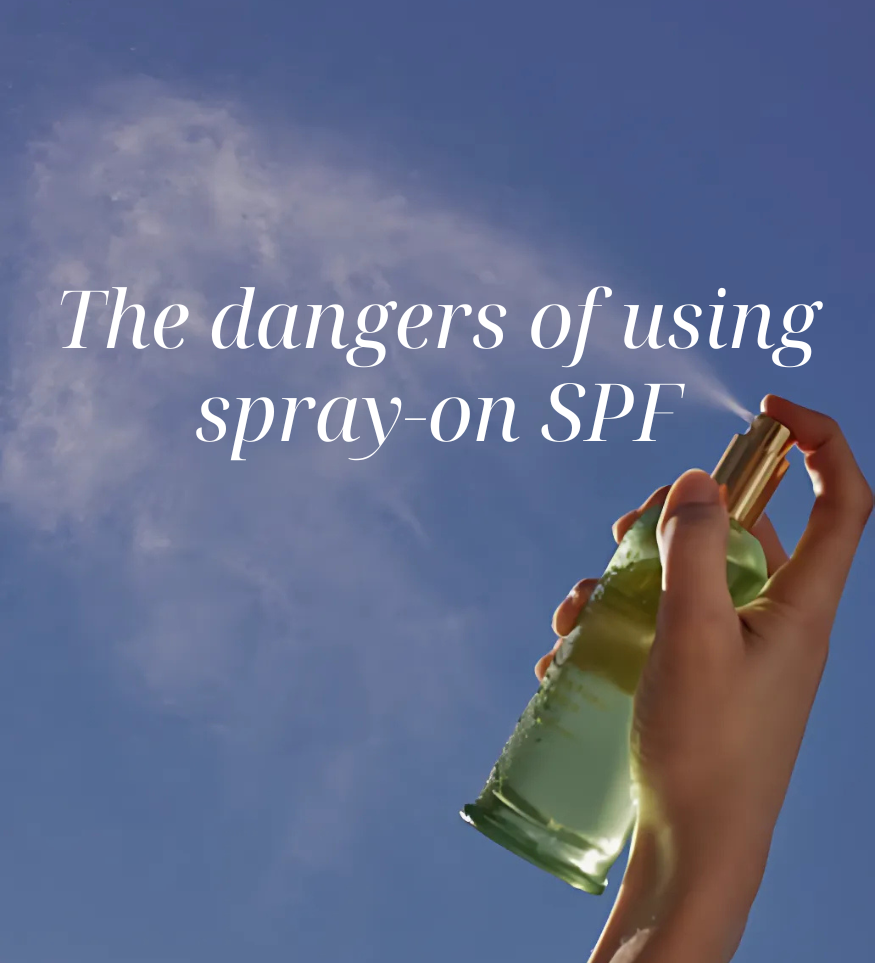
One of the BIGGEST mistakes you can make with SPF, are spray-on sunscreens enough when it comes to protection?
1. Why is spray-on SPF not effective in protecting against UV damage?
When it comes to UVA/UVB protection with SPF and sunscreen, APPLICATION IS EVERYTHING!
It’s what we refer to as an exponential dose delivery curve.

So if you under apply by half you are getting less than a quarter of the SPF labelled on the product, and we know for a fact that 80% of consumers under apply by half!
Throw in a spray-on application that is aerosolised and you have a disaster for your skin getting practically no protection and simply burnt or what I like to term as “skin cancer suicide”.
Aerosolised spray-on products are tested in their pure liquid form BEFORE they are put into an aerosolised format.
So the testing is not reflective of the spray-on final product which is significantly diluted form the original liquid form that “gains” its SPF rating.
You would have to meticulously spray multiple layers to achieve the SPF that is advertised on the can - we're talking at least 6 layers to be exact!
Then add in the issues of technique! Spray-on application lends itself to human error.
Easy to miss the target (your skin). Then add a few environmental factors like the wind, and your “SPF” is literally blowing off in the wind…
Whether it is aerosolised or non-aerosolised, all spray-on SPF products have the same issue.
Creams and lotions format wins every time! You can see it AND it goes on in a consistent controlled layer.
2. If re-applying is the issue of getting patients to comply to regular SPF application, what is a more effective alternative to re-applying if not a spray-on SPF?
To be honest there are some great SPF products that can be applied layer upon layer and not ball or pile up. They tend to be mineral in nature, like my dr.NC Concentrated CC+ Cream SPF 30 AND our FaceShield SPF TRUE 50 Invisible Tint.
For those serious about UVA/UVB AND pigmentation prevention, I recommend wearing both of these products.
First, the FaceShield SPF TRUE 50 Invisible Tint, then your colour correcting CC+ Cream SPF 30. Both are mineral only SPF so the formulas integrate perfectly. Both also have Niacinamide which gives you antioxidant and infrared radiation protection. Layer upon layer of B3 insuring global environmental protection.
Simply reapply your blush and lip and off you go.
The spray on products are honestly delivering a false sense of security.
As do loose powder mineral SPF!!!
You simply are not getting the coverage and appropriate distribution of the UVA/UVB protecting ingredients.
If you are outdoors swimming, sporting etc. then reapplying a lotion or cream SPF is really not a big deal. Add my Concentrated CC+ Cream with SPF over the top for extra protection and skin perfection!
3. Is chemical SPF and physical-based SPF that much different in their protection?
NOT ALL SUNSCREENS / SPF PRODUCTS ARE CREATED EQUALLY!
However, the Australian standards and testing are probably the best in the world so another reason to buy Australian made AND Australian tested when it comes to SPF.
Different ingredients have different spectrums of UV and visible light that they “block” or protect from.
For example, Zinc is a great UVA blocker, whereas Titanium dioxide is a great UVB blocker. SO ideally you want to have a product that has both. Just like what I have done in my FaceShield SPF True 50 Invisible Tint and Concentrated CC+ Cream SPF 30.
Similar for chemical SPF ingredients. Different ones are better at protecting against different UV wavelengths, so you need a combination.
I love physical blockers as they are natural minerals that have no allergenic potential.
However, they are harder to formulate, can be more expensive and can be whitening if you are going for high SPF. Hence the reason why my FaceShield SPF TRUE 50 has taken me nearly 18 years to with multiple failed attempts to perfect with no white casts.
The tint I also love as we now know that iron oxides give you protection from visible light. Just another element we need to be worried about when it comes to skin ageing and damage!


























